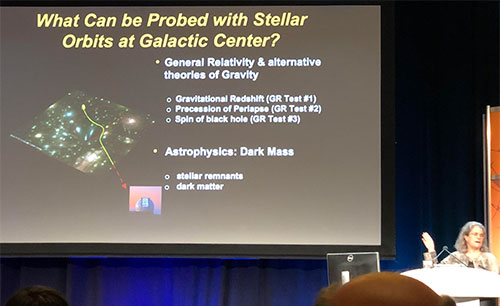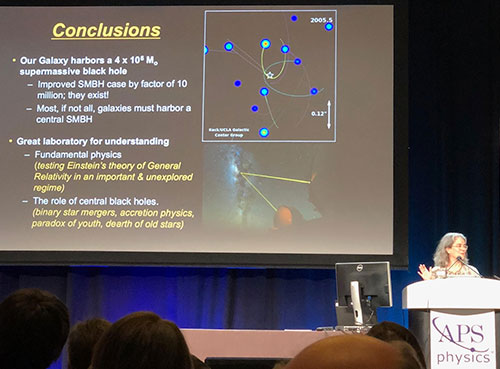Well it has come down to my last day at the American Physical Society (APS) April meeting in Denver, Colorado. I just happened to look up at the cloudy sky and could see right away that there was a sign, sort of an "x" that marked the spot, that I was in the right place.
We have a long history of looking to the sky for guidance and in this case the symbol seems to have been right on!
 |
| X marks the spot for great physics at the April APS Meeting in Denver (Source: Palmia Observatory) |
The APS meeting is structured between sessions having invited speakers who have 30 minutes for their more general audience presentation and other sessions where more technical and directed research results are presented with just 10 minutes for each presentation. The topics are arranged by divisions within APS such as Astrophysics, Atomic Physics, Nuclear Physics, Gravitational Physics, and Particle and Beam Physics. So, one can pick and choose depending on their particular interest which sessions to attend. My emphasis has been on the astrophysical and gravitational topics and it is those sessions that I have tried to provide in these brief summaries. If you are more interested in condensed matter physics or foundations of quantum mechanics, then the APS March meeting is more for you.
So for my last APS April summary, let's take a look at the invited presentation by Andrea Ghez, UCLA, who has been studying the galactic center and has tracked the orbits of stars about the black hole for many years now. Her presentation was one of the best from my physicist wannabe perspective.
 |
| The Galactic Center as unique laboratory for black hole physics (Andrea Ghez, UCLA, at APS Meeting in Denver) |
The curious relationship between the mass of the galaxy black hole and the total mass of the galaxy bulge is an ongoing mystery. What is the cause and what is the effect?
 |
| Black Hole mass and mass of the galaxy bulge are correlated (Andrea Ghez, UCLA, at APS Meeting in Denver) |
So to start looking into the nature of black holes and the galaxies that host them or from the other way around, the black holes that host galaxies, the answer, if there is one, starts with what can be probed at the galactic center. The orbits of stars around the center part of the galaxy eventually found that the orbit around Sgr A*, was determined to be a black hole. Now further tests and observations can be used to test and verify Einstein General Relativity predictions.
 |
| The Galactic Center as unique laboratory for black hole physics (Andrea Ghez, UCLA, at APS Meeting in Denver) |
The orbit of SO-2 around the black hole has now been observed long enough that it has covered one full orbit. Now the predictions of general relativity are that the orbit should precess not return to its original starting position as predicted by Newtonian dynamics. It is pretty neat that observations like this can be made through all the dust near the galactic center.
 |
| Advance of the SO-2 periapse is next upcoming test of GR (Andrea Ghez, UCLA, at APS Meeting in Denver)Add caption |
You can notice right away the change in velocity as the orbit reaches its closest approach to the central gravitational source and the velocity goes very quickly from approaching to receding. Andrea told us that the observers were very lucky to be able to see the closest approach. Why? Remember that for half of the year our sun is in the way and we can't see the center of the galaxy! The velocities are the radial velocities as observed here on Earth through spectroscopic redshift measurements.
 |
| Luckily, the closest approach of SO-2 to Sgr A* was visible (Andrea Ghez, UCLA, at APS Meeting in Denver) |
Andrea then spent some time talking about the statistics of astronomical observations and the distinction between random errors and systematic errors. Unfortunately, at this time I started to suffer a bit of sleepiness, caused by maybe too many Bloody Marys at breakfast, or not enough coffee from Starbucks, or the Krispy Kreme donut after breakfast, or the 3 martini lunch at the Yard House or some such effect, but I missed or napped just a little during part of the lecture.
Darn, this statistics part is a key part of the science behind astronomical observations! The slide below shows, as best as I can remember and piece together after the fact, shows the results from two different observatories or two different instruments, where we see the random error associated with each, but the systematic error shows up clearly. We would like to see the two separate measurement results to just lie right on top of each other with their own random fuzziness there as well. I think this is what the part of her presentation was all about. Anyway, we know that understanding the random sources of error and the systematic sources of error are key parts of astronomical observations. Astronomy already has two outstanding sources of tension about the value of the Hubble constant, which illustrates the issue between random and systematic errors. Is there some systematic error or inconsistency in the systematic modelling that is responsible for the difference in the two published values of the Hubble constant? I think this issue is what this part of the talk was all about. Any other ideas?
 |
| The Galactic Center as unique laboratory for black hole physics (Andrea Ghez, UCLA, at APS Meeting in Denver) |
Ok, now mostly all awake again, Andrea talked about how the gravitational redshift for the radial velocity of SO-2 around the black hole has now been measured. The slide below shows the predictions from old Newtonian gravity and predictions from general relativity and again the GR predictions are confirmed.
 | |
|
Next up, Andrea talked about how the upcoming measurements of the precession of SO-2 orbit will provide additional testing of GR and put constraints of any possible 5th force or other interpretation of the data. Again, you can see the effects of science in action as each experiment, able to cover only its specific design region, carves out and excludes additional forces. When all of the results of these individual experiments are combined, the result is the ruling out of other forces over the whole domain.
 |
| The Galactic Center unique laboratory constrains any 5th force (Andrea Ghez, UCLA, at APS Meeting in Denver) |
As many of you will remember, the popular science shows talked about this infamous object, G2, which was, as I recall, thought to be some sort of gas cloud that was about to be shredded as it came closer and closer to its closest approach to Sgr A*. Well, it seems that now after many more observations we may finally be getting to a better understanding of what G2 is. As background for Andrea's next slide, let's return briefly to a slide from the Gravity Collaboration presentation, which shows the orbital measurements of G2. Here the Gravity Collaboration found that the orbit of G2 was being affected by additional drag forces, as if maybe by a gaseous component.
 |
| Orbital measurement history for G2 (Source: Stefan Gillessen, Gravity Collaboration at APS Meeting in Denver) |
So, was G2 initially a large gas cloud or what? The recent measurements as seen in the slide below seem to indicate that G2 may be a black hoe driven merger of a binary star system. Oh-oh, Andrea mention the merger could be due to this strange sounding effect, called the Kozai-LIdov effect. What is that? Hmm, I'll have to look that up!
 |
| G2 might be merging binary stars and not gas cloud (Andrea Ghez, UCLA, at APS Meeting in Denver) |
It turns out that many stars are found as binaries. The previously mentioned Kozai-Lidov effect is a celestial mechanics effect where the orbital parameters of a binary star system can be widely perturbed by the presence of a third gravitational body. The black hole and orbital interaction with binary systems might be able to explain other unexpected results. See below.
 |
| Looking to binary star systems in the galactic center for other answers (Andrea Ghez, UCLA, at APS Meeting in Denver) |
Finally, Andrea summarized her presentation as see below. We are getting a pretty good picture of the center our own Milky Way. With the recent findings from the EHT regarding the galactic center of M87, we are all waiting for the EHT results of their observation of the black hole in the Milky Way.
 |
| No more doubt about black hole at the galactic center (Andrea Ghez, UCLA, at APS Meeting in Denver) |
So after Andrea's fantastic session, it was my time to check out of the hotel and take the train to the airport to fly back to Orange County. A final look around the hotel space where most of the vendors, including the four textbook publishers, were mostly already packed up. Whew, at least I can't pick up any more books, even at a discount, for my already stuffed suitcase! All in all, it was a pretty good meeting, but it is time to head back to the observatory.
 |
| Getting close to the last day of the APS meeting at the Sheraton Denver Downtown (Source: Palmia Observatory) |
Until next time,
Resident Astronomer George
Be sure to check out over 300 other blog posts on similar topics
If you are interested in things astronomical or in astrophysics and cosmology
Check out this blog at www.palmiaobservatory.com

No comments:
Post a Comment